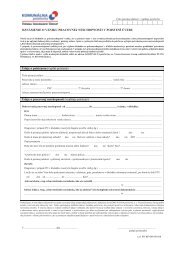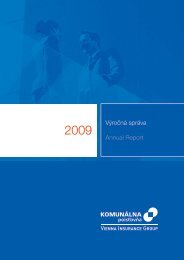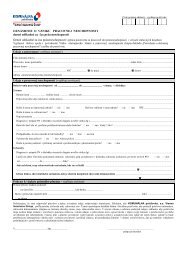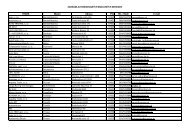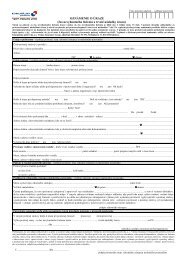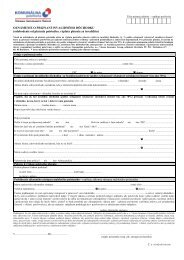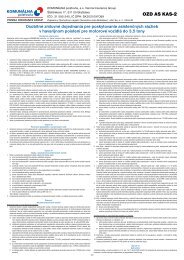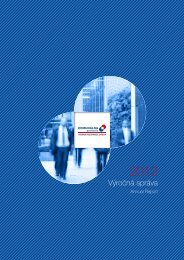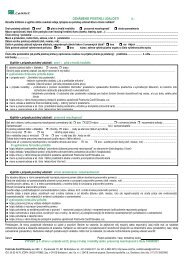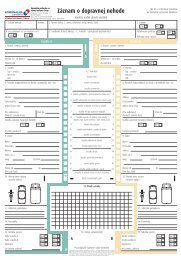kontinuita - Komunálna Poisťovňa
kontinuita - Komunálna Poisťovňa
kontinuita - Komunálna Poisťovňa
Create successful ePaper yourself
Turn your PDF publications into a flip-book with our unique Google optimized e-Paper software.
NOTES TO<br />
THE FINANCIAL<br />
STATEMENTS<br />
from customers. The Company is currently assessing<br />
the impact of this interpretation on its separate financial<br />
statements. IFRIC 18 has not yet been adopted by<br />
the EU.<br />
Improving Disclosures about Financial Instruments -<br />
Amendment to IFRS 7, Financial Instruments: Disclosures<br />
(revised in March 2009; effective for annual periods<br />
beginning on or after 1 January 2009). The<br />
Company will be required to disclose an analysis of financial<br />
instruments using a three-level fair value<br />
measurement hierarchy. The amendment (a) clarifies<br />
that the maturity analysis of liabilities should include<br />
issued financial guarantee contracts at the maximum<br />
amount of the guarantee in the earliest period in which<br />
the guarantee could be called; and (b) requires disclosure<br />
of remaining contractual maturities of financial<br />
derivatives if the contractual maturities are essential<br />
for an understanding of the timing of the cash flows.<br />
The Company will further have to disclose a maturity<br />
analysis of financial assets it holds for managing liquidity<br />
risk, if that information is necessary to enable<br />
users of its financial statements to evaluate the nature<br />
and extent of liquidity risk. The amendment has not yet<br />
been adopted by the EU.<br />
Improvements to International Financial Reporting<br />
Standards (issued in May 2008). In 2007, the International<br />
Accounting Standards Board (“IASB”) decided to<br />
initiate an annual improvements project as a method of<br />
making necessary, but non-urgent, amendments to<br />
IFRS. The amendments consist of a mixture of substantive<br />
changes, clarifications, and changes in terminology<br />
in various standards. The substantive changes<br />
relate to the following areas: classification as held for<br />
sale under IFRS 5 in case of a loss of control over a<br />
subsidiary; possibility of presentation of financial instruments<br />
held for trading as non-current under IAS<br />
1; accounting for sale of IAS 16 assets which were previously<br />
held for rental and classification of the related<br />
cash flows under IAS 7 as cash flows from operating<br />
activities; clarification of definition of a curtailment<br />
under IAS 19; accounting for below market interest<br />
rate government loans in accordance with IAS 20;<br />
making the definition of borrowing costs in IAS 23 consistent<br />
with the effective interest method; clarification<br />
of accounting for subsidiaries held for sale under IAS<br />
27 and IFRS 5; reduction in the disclosure requirements<br />
relating to associates and joint ventures under<br />
IAS 28 and IAS 31; enhancement of disclosures required<br />
by IAS 36; clarification of accounting for advertising<br />
costs under IAS 38; amending the definition of<br />
the fair value through profit or loss category to be consistent<br />
with hedge accounting under IAS 39; introduction<br />
of accounting for investment properties under<br />
construction in accordance with IAS 40; and reduction<br />
in restrictions over manner of determining fair value<br />
of biological assets under IAS 41. Further amendments<br />
made to IAS 8, 10, 18, 20, 29, 34, 40, 41 and to IFRS 7<br />
represent terminology or editorial changes only, which<br />
the IASB believes have no or minimal effect on accounting.<br />
The Company does not expect the amendments<br />
to have any material effect on its separate<br />
financial statements. The improvement project has<br />
been adopted by the EU.<br />
Unless otherwise described above, the new standards<br />
and interpretations are not expected to significantly affect<br />
the Company’s financial statements.<br />
2.2 Foreign currency translation<br />
(i) Functional and presentation currency<br />
Items included in the Company’s financial statements<br />
are stated in the currency of the primary economic environment<br />
in which the Company operates (functional<br />
currency). The financial statements are presented in<br />
Slovak crowns, which is the Company’s functional and<br />
presentation currency.<br />
(ii) Transactions and balances<br />
Foreign currency transactions are converted into the<br />
functional currency using the exchange rates effective<br />
at the transaction dates. Foreign exchange gains and<br />
KONTINUITA ANNUAL REPORT 101



